- Friedman, Thomas L. That Used To Be Us: What Went Wrong With America - And How It Can Come BackBinding : Taschenbuch, Label : Abacus, Publisher : Abacus, NumberOfItems : 1, medium : Taschenbuch, numberOfPages : 380, publicationDate : 2012-06-07, authors : Friedman, Thomas L., Michael Mandelbaum, languages : english, ISBN : 0349000093
- Friedman, Thomas L. That Used To Be Us: How America Fell Behind In The World It Invented And How We Can Come BackBinding : Gebundene Ausgabe, Label : Macmillan Us, Publisher : Macmillan Us, NumberOfItems : 1, medium : Gebundene Ausgabe, numberOfPages : 400, publicationDate : 2011-09-05, authors : Friedman, Thomas L., Michael Mandelbaum, languages : english, ISBN : 0374288909
- DJ Yoda How To Cut & Paste-Mixtape Vol.2Binding : Audio CD, Label : Sanctuary (rough trade), Publisher : Sanctuary (rough trade), NumberOfDiscs : 1, medium : Audio CD, releaseDate : 2002-08-12, artists : DJ Yoda
- Staedtler Feutres de coloriage double pointe Design Journey couleurs assorties - Pochette de 36Ces feutres de coloriage conviennent pour les croquis, les dessins et illustrations ainsi que l'écriture et le coloriage. Feutre de coloriage double pointe.<br/><br/>Corps en polypropylène.<br/>Largeur du tracé : 0,5 -3 mm.<br/><br/>Capuchon ventilé (ISO 11540). - Offre exclusivement réservée aux professionnels
- Sycomore CRE6012 - Coloriage Enfant - Coloriages Villes 40 Pages - 3+ Ans SYCOMORE
- Coloriages Dorés Sirènes : Tableaux À Détacher Et À Offrir !Binding : Taschenbuch, Label : Deux Coqs d'or, Publisher : Deux Coqs d'or, medium : Taschenbuch, publicationDate : 2018-01-24, ISBN : 2016276738
- Staedtler Set 72 Feutres de coloriage double pointe fine 0,5 à 0,8mm et large 3mm, à base d'eau, assortisFeutres Design Journey<br/>Feutres double pointe.<br/>Pour de multiples applications : croquis, dessins, illustrations, écriture et coloriage, ...<br/>Encre à base d'eau et colorants alimentaires, lavable sur la plupart des textiles.<br/>Largeur de trait : pointe large 3 mm et pointe fine 0,5 à 0,8 mm.<br/>Conforme à la norme EN 71.<br/>Set en plastique rigide transparent pegboardable.<br/>Set de 72 feutres - Offre exclusivement réservée aux professionnels
- Ozzé Coloriages érotiques pour adultesJe suis le livre de Coloriages érotiques pour adultes de Ozzé. Original et divertissant, je suis un excellent cadeau à offrir à ses amis, par exemple pour un EVJF ou un EVJG ! Être adulte ne signifie pas ne plus être joueur ou joueuse...Je cache de nombreux coloriages au fil de mes pages, tous plus coquins les uns que les autres. Concentrez-vous pour colorier sans dépasser les lignes... Y arriverez-vous Dans tous les cas, vous passerez un bon moment !
- Bic Feutres de coloriage Visacolor XL ECOlutions® gigapack X288Kit Visacolor XL feutres + abécédaire<br/>Feutres de coloriage pointe Large.<br/>Maxi Schoolpack de 238 feutres + 50 gratuits + 1 Abécédaire à colorier pour apprendre l'alphabet.<br/>Couleurs assorties.<br/>Le kit - Offre exclusivement réservée aux professionnels
- Dessin Et Coloriage Enfant Djeco Coffret Feutres Pinceaux 24 PiècesDessin et coloriage enfant Djeco Coffret feutres pinceaux 24 pièces - Dessin et coloriage enfant. Achat et vente de jouets, jeux de société, produits de puériculture. Découvrez les Univers Playmobil, Légo, FisherPrice, Vtech ainsi que les grandes marques de puériculture : , , Mac Laren, ...
- Bic Plastidecor Craies de Coloriage - Couleurs Assorties, Etui Carton de 12 - Lot de 5 VioletÀ la maison ou à l'école, les craies de couleur BIC Kids Plastidecor sont parfaites pour initier les enfants dès 30 mois au monde du dessin et du coloriage.<br/>Leur palette de 24 couleurs comprend des couleurs vives et métalliques pour stimuler la créativité des artistes en herbe.<br/>Adaptées aux petites mains, elles ont une taille de 12 cm (alors qu'un crayon standard mesure 17cm).<br/>Leur corps en cire plastique est extra résistant et leur mine plus solide que celle des crayons de couleur normaux, afin de mieux résister aux chutes et à la forte pression des petites mains sur le papier.<br/>Aucun risque de se salir avec ces craies qui laissent les mains et les tissus propres.<br/>Elles se taillent avec un taille-crayon classique, sans en obstruer les trous.<br/>L'entreprise BIC fabrique depuis plus de 65 ans des produits de grande qualité, distribués partout dans le monde et vendus au meilleur prix.<br/>Avec sa gamme BIC Kids, BIC propose des instruments de coloriage spécialement conçus pour le développement et le confort des enfants. - Offre exclusivement réservée aux professionnels
- Bic Plastidecor Craies de Coloriage - Couleurs Assorties, Classpack de 288Crayons plastiques Plastidécor<br/>Diamètres des crayons : 9 mm - mine Ø 4 mm.<br/>Couleurs assorties.<br/>Ne salit pas les mains.<br/>Schoolpack de 288 - Offre exclusivement réservée aux professionnels
- BIC KIDS Kit de coloriage pour le voyage 'MEMORY GAME'Dans une mallette en métal, 64 pièces, dimensions de la<br/><br/>mallette: (L)207 x (P)157 x (H)71 mm, contenu: 12x crayon<br/><br/>de couleur triangulaire Evolutuion Triangle, 12x crayon cire<br/><br/>triangulaire Plasticolor Triangle, 8x feutre Visacolor XL,<br/><br/><br/><br/>jeu de mémory de 32 pièces à colorier - Offre exclusivement réservée aux professionnels
- Bic Decoralo Feutres de Coloriage à Pointe Extra-Large - Couleurs Assorties, Classpack de 48 AluminiumLes feutres de coloriage BIC Kids Decoralo voient tout en grand.<br/>Avec leur très large format, ils sont parfaitement adaptés aux mains des enfants dès 3 ans.<br/>Leur pointe XXL dessine avec un trait épais bien visible et permet de colorier de larges surfaces.<br/>Ils se déclinent en 12 couleurs d'encre éclatantes pour de magnifiques dessins et une joyeuse découverte des couleurs.<br/>Pas de panique en cas d'oubli, les feutres de coloriage Décoralo ne sèchent pas et peuvent rester sans capuchon pendant 3 jours (sauf le noir).<br/>Pour découvrir le monde des couleurs en toute sérénité, leur encre à base d'eau est facilement lavable sur la plupart des tissus.<br/>La gamme BIC Kids permet aux enfants de découvrir le coloriage, activité créative et calme aux multiples bienfaits.<br/>En effet, il stimule le développement psychomoteur des enfants, sert à l'apprentissage des couleurs, développe leur confiance en eux.<br/>C'est une aussi première initiation à l'apprentissage de l'écriture.<br/>Pour télécharger de nombreux coloriages et obtenir plus d'informations, rendez-vous sur le site internet BIC Kids. - Offre exclusivement réservée aux professionnels
- Staedtler Pochette de 10 feutres de coloriage double pointe de 2 couleurs et de 2 pointes différentes. - Lot de 3Feutre double pointe<br/>Etui de 10 feutres pegboardable en carton, composé à 80 % minimum de matériaux recyclés.<br/>Feutres de coloriage double pointe moyenne 1,0 mm et large 3,0 mm de 2 couleurs différentes soit 20 couleurs.<br/>Pointe bloquée solide et résistante à la pression.<br/>Encre à base d'eau et de colorants alimentaires, lavable sur la plupart des textiles.<br/>Produit éco-responsable :<br/>Recyclé à 80% - Offre exclusivement réservée aux professionnels
- Bic Visa Feutres de Coloriage à Pointe Fine - Couleurs Assorties, Classpack de 288 BlancLa gamme BIC Kids propose des produits de coloriage spécialement adaptés au développement, au confort et à la créativité des enfants.<br/>Les feutres de coloriage Visa ont une pointe fine qui permet d'effectuer des contours nets et des coloriages précis.<br/>Pas de panique en cas de petite bêtise, leur encre à base d'eau est lavable sur la plupart des vêtements.<br/>Ils se referment facilement grâce à un capuchon ventilé.<br/>Mais ils peuvent aussi sortir sans leur capuchon car leur encre spéciale ne sèchera pas même s'ils sont décapuchonnés pendant 3 mois (sauf l'encre noire).<br/>Gage de qualité, ces feutres sont fabriqués dans les usines de l'entreprise BIC avec un savoir faire unique.<br/>La couleur du feutre, comme celle du bouchon et de la mine sont très vives.<br/>Avec BIC, dessinez dans la bonne humeur. - Offre exclusivement réservée aux professionnels
- Pelikan Feutre de coloriage colorella, aquarellable, étui 6 - Lot de 3S'applique et se mélange au pinceau et à l'eau, lavable sur<br/><br/>la plupart des tissus, capuchon ventilé, pointe ogive,<br/><br/>largeur du tracé: env.<br/>2,0 à 43,0 mm<br/><br/>contenu : 6 feutres - Offre exclusivement réservée aux professionnels
- Bic Ecriture Visaquarelle Feutres de Coloriage avec Pointe Pinceau - Couleurs Assorties, Pot de 48 BlancFeutres Pinceaux Visaquarelle<br/>Feutres pointe extra souple indéformable et bloquée.<br/>Peut rester ouvert 4 semaines sans sécher ! Couleurs assorties.<br/>Pot de 48 - Offre exclusivement réservée aux professionnels
- Ambiance-sticker Sticker prénom personnalisable style coloriageDes stickers prénoms pour votre déco ! Avec les stickers muraux prénoms et ce Sticker prénom personnalisable style coloriage, vous pourrez enfin décorer l'intérieur de votre maison à votre guise ! Ce sticker nom style coloriage est à la fois amusant et original, vos enfants vont adorer. Où coller c
- Bic Etui de 24 feutres de coloriage Intensity premium. Grip caoutchouc. Couleurs assorties. JauneBoîte de 24 feutres Intensity Premium<br/>Produit éco-responsable :<br/>FSC - Offre exclusivement réservée aux professionnels
- Bic Kid Couleur Feutres de Coloriage à Pointe Moyenne - Couleurs Assorties, Classpack de 144La gamme BIC Kids propose des instruments de coloriage spécialement conçus pour le développement, le confort et la sécurité des enfants.<br/>Parfaits pour le coloriage quotidien des enfants dès 5 ans, les feutres Kid Couleur ont plus d'une corde à leur arc.<br/>Déclinés en 24 couleurs lumineuses, ils permettent des dessins vifs et riches en contrastes.<br/>Leur pointe moyenne bloquée ne s'enfonce pas à la pression sur le papier.<br/>Ils sont donc adaptés à une longue utilisation alternant contours précis et coloriages intensifs.<br/>Pas de panique en cas de petite bêtise, ces feutres de coloriage sont ultra lavables.<br/>Les feutres Kid Couleur sont solides et fiables : ils sont fabriqués en France dans les usines de l'entreprise BIC avec un savoir faire unique.<br/>Merci qui ?<br/>Les feutres Kid Couleur bien sûr. - Offre exclusivement réservée aux professionnels
- Bic Boîte métal de 20 feutres de coloriage pointe fine (0,8mm). Corps Noir. 10 couleurs assorties - Lot de 2 BleuCONTE<br/>Crayons de couleur.<br/>Boîte de 24 feutres. - Offre exclusivement réservée aux professionnels
- Welcome Family Kit de coloriage 60 cahiers + crayonsUne solution pour valoriser vos formules enfants et fidéliser vos clients. Pack composé de 60 cahiers de coloriage avec 6 thèmes différents (filles, garçons) et de 60 boîtes de 4 crayons de couleurs.
- Bic Visacolor XL Feutres de Coloriage à Pointe Large - Couleurs Assorties, Etui Carton de 12 - Lot de 2La gamme BIC Kids propose des outils de coloriage spécialement conçus pour développer la psycho-motricité des enfants tout en leur offrant un confort optimal.<br/>Le coloriage permet l'apprentissage des couleurs et développe la créativité des enfants et leur confiance en eux.<br/>Déclinés en 24 couleurs très vives, les feutres à pointe large Visacolor XL de BIC Kids sont recommandés dès 3 ans.<br/>Leur corps rond est facile à saisir, et leur pointe bloquée ne s'enfonce pas à la pression sur le papier.<br/>Ils permettent ainsi de colorier des larges aplats et de dessiner des contours épais.<br/>Pas de panique en cas de petite bêtise, leur encre à base d'eau est lavable sur la plupart des tissus.<br/>Gage de qualité, ces feutres sont fabriqués dans les propres usines de l'entreprise BIC avec un savoir-faire unique.<br/>Coloriez en toute tranquilité.<br/>Produit éco-responsable :<br/>Recyclé à 54%<br/>NF Environnement - Offre exclusivement réservée aux professionnels
- COPPENRATH Jeu de coloriage cartes pailletées princesse LillifeeCaractéristiques : A partir de 3 ans Loisir créatif avec princesse Lillifee : ensemble de cartes pailletées à colorier Die Spiegelburg comme activité idéale pour princesses créatives Ensemble créatif incluant 8 crayons de couleur à paillettes pour compléter les 6 cartes à motifs à paillettes...
- Feutre de coloriage 'Korello', large, étui de 24 - Lot de 2Pointe variable, largeur de tracé: 1-4 mm, couleurs<br/><br/>brillantes, non toxique, capuchon ventilé, lavable, assorti,<br/><br/>contenu: 24 pièces<br/><br/><br/><br/>étui en carton - Offre exclusivement réservée aux professionnels
- Dining Kids Livres de coloriage Cuisinier, contenu de l'emballage : 50 piècesLivres de coloriage de 8 pages au format A5. Paquet de 50 pièces. Crayons de couleur disponibles en set de 6 couleurs. Paquet de 24.<br><br>50 pièces A5<br><br>Également disponible avec le thème 'Page d'hôtel' (produit H121)<br><br>Crayons de couleur : H123<br><br>Dimensions totales : 21,5(H) x 15,5(L) x 5(P)cm<br><br>Poids : 820g
The Great Bible is often seen as a monument of English reform – but could it also contain the first known example of political photoshopping in early modern England? Printed in 1538-9, it was to be purchased by every parish church in the realm. Its creation was overseen by Henry VIII’s chief minister, Thomas Cromwell. The Great Bible ushered in the English parish Bible and its large size and meticulous printing set the bar for centuries to come. Nowhere is its iconic appearance more evident than in a unique presentation copy made for the Tudor court. This copy was printed on vellum and hand-coloured by highly skilled illuminators.
I encountered this lavish copy while carrying out an in-depth study of the production and use of Bibles in late medieval and early modern England. Researchers have long known about the Great Bible and used its striking title page for illustration. But little or no scientific analysis has ever been carried out on it. So I asked Paola Ricciardi, scientist in residence at the Fitzwilliam Museum in Cambridge, to help me with a new investigation which utilised the latest technology to study the Bible in forensic detail. The results blew us away.
Our analysis revealed a new – and hitherto unknown – plot by Cromwell to literally change the balance of power on the Bible’s front page, just one year before his execution for high treason. We plan to publish our research results in full later this year.
As Lord Privy Seal and Vicegerent in Spirituals (Henry’s deputy in matters relating to the church), Cromwell was the most powerful man in Henry VIII’s court. Henry’s break from the Catholic Church and the dissolution of the monasteries became an opportunity for Cromwell to advance religious reform. For Cromwell, support for a vernacular Bible (translated into English for the general population) was linked with obedience to the King. But he had to counter a strong opposition and a substantial conservative faction in court and within the church. Henry’s support for religious reform was always limited. His stance on religion was influenced more by his political aims, rather than faith, so his support for a vernacular Bible was hesitant from the start.
Cromwell thought that the best way to ensure royal support was to produce a Bible worthy of royal patronage – both in its content and in its material grandeur. Such a Bible would combine Cromwell’s own evangelical leanings with the political aim of consolidating Henry’s control over the English church. Production began in Paris. English printers were simply not equipped to produce a book of the magnitude sought by Cromwell.
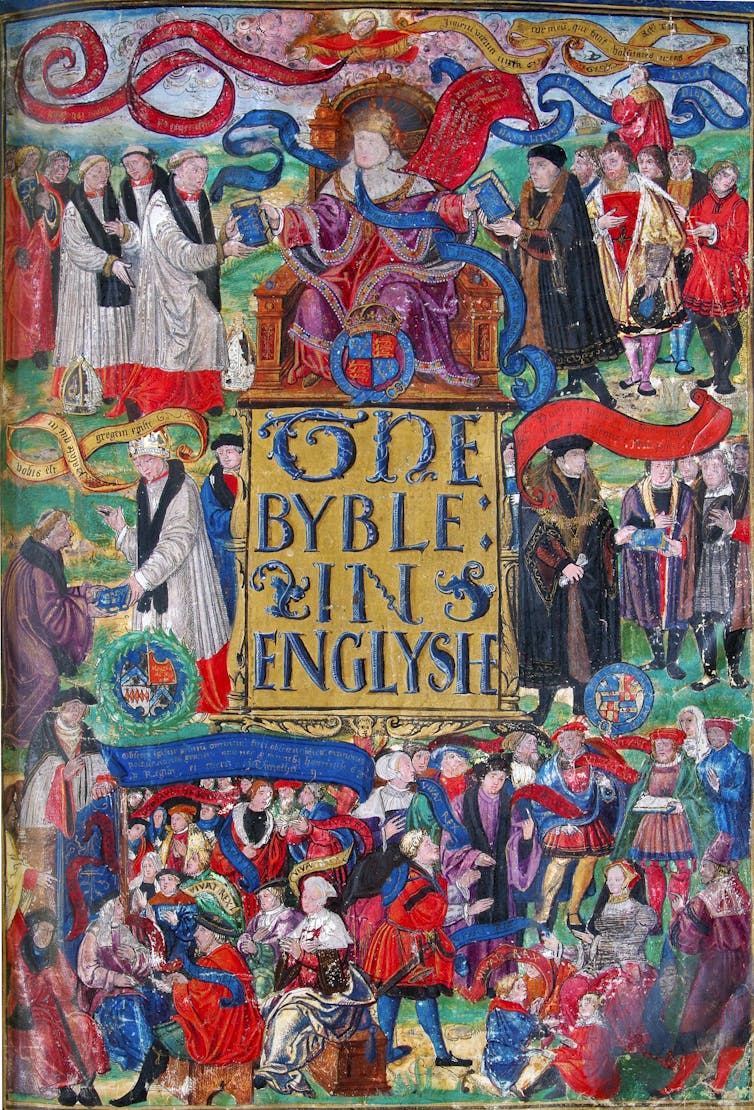
A letter to Cromwell from the production team in Paris dated June 23, 1538, reveals that two luxurious vellum copies of the Bible were being prepared. It reads: “We have here sent unto your lordship two examples, one in parchment, wherein we intend to print one for the King’s grace, and another for your lordship.”
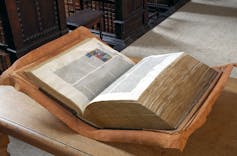
St John’s College, Cambridge.
Ian McKee/St John’s College
Printed on parchment and meticulously hand-coloured, these copies have survived – one at the National Library of Wales and the other in St John’s College, Cambridge. In November 2019, with the kind assistance of St John’s College, we engaged in a technical and scientific investigation of their copy of the Great Bible.
Scientific analysis
We employed various non-invasive analytical techniques to examine the St John’s Bible, including X-ray fluorescence (XRF) spectroscopy, reflectance spectroscopy (in the ultraviolet, visible and near-infrared range), high-resolution digital microscopy and advanced technical imaging. Scientific investigation of works of art has much to offer and is more reliable for material identification than visual analysis (historically the primary identification method for painting materials and techniques).
The focus of our technical examination of the Bible was the decoration. Knowledge of the painting materials and techniques used to decorate books can provide a wealth of information on production methods and artists’ skills –and, occasionally, on their identity. All of the hundreds of black-and-white images printed in the Bible were painstakingly hand-coloured by a group of talented artists for this special presentation Bible. In some cases, the artists did not simply colour in the print, but made significant changes to the black-and-white printed images used in the regular editions of the Bible.
Our investigation focused on 14 images, spread out across the volume. First, we used a range of spectroscopic methods to analyse a selection of small areas in each image, allowing the identification of individual pigments. The pigments identified throughout the volume were consistent with what is known about the materials used by Continental painters and illuminators during the 16th century. One of the most interesting results of this investigation was the fact that different “palettes” can be identified in different images, which suggests the presence of no less than six (and quite possibly more) artists at work on the decoration of this Bible.
The spectroscopic analysis was followed by high-magnification digital microscopy (in direct as well as raking and transmitted light). The close-up images captured using these methods not only provided greater insight into the stylistic preferences and working methods of the artists, but were also crucial in revealing the extent to which the printed images were modified at the painting stage.
From black and white to colour
We paid special attention to the Bible’s title pages. Each of the book’s five parts is preceded by a full, illustrated and meticulously hand-coloured title page. The title pages depict scenes from the parts of the Bible they precede (historical books, the words of the prophets, or the New Testament). We discovered that the St John Bible’s main front page was actually a hand-coloured adaption of the printed black-and-white version which would have been present in all the mass-produced Bibles. But this luxurious front page – meant for the eyes of King Henry VIII – contained some key differences, as the slider image below illustrates.
The main black-and-white title page depicts an ideal scenario in which the majestic Henry VIII distributes bibles to lay and religious subjects, assisted by two of his faithful ministers – Thomas Cranmer, Archbishop of Canterbury, and Cromwell. Renowned art historian Tatiana String believes the printed title page was the visual manifestation of Henry’s authority. Henry reigns at the top of the page, distributing bibles to laypeople and clerics, aided by Cromwell to his left and Cranmer to his right (each identified by his coat of arms). The Word of God then reaches the general public in the lower part of the page, who duly proclaim “vivat rex” and “God save the king” (apart from those in prison, who are seen on the bottom right and shout nothing).
This black-and-white title page of the Bible masterminded by Cromwell, distilled his theory of scripture and obedience. The dissemination of the Bible was from top to bottom (literally), resulting in greater submission to the monarch. Its details reveal, however, that it moves away from the more radical reformation ideal of putting the Bible “in the ploughboy’s hands”. The laity at the bottom of the page do not hold the Bible, they simply listen to the Word of God preached from the pulpit. This was a nuanced and hierarchical way to disseminate the book and it reflected the unease Henry had with common people reading the Bible.
In the St John’s copy, the printed title pages were carefully hand painted, with the original print at times peeping through. For example, in the hand-coloured version the prison was obliterated and replaced by a dedication scene. The original brick background is still visible through the red stockings of the green-clad figure.
Cut and paste politics
The most striking modification we found has so far been hidden from scholars working on this Bible. Under a microscope with raking light, it becomes evident that some of the faces were painted on separate pieces of vellum and pasted over the existing page. A thin line can be seen under Cromwell’s face where the image was pasted in. This was done in a highly professional manner, covering much of the border area with paint overlapping the edges and creating the impression of a single image. This major modification applied to Cromwell and another key figure.
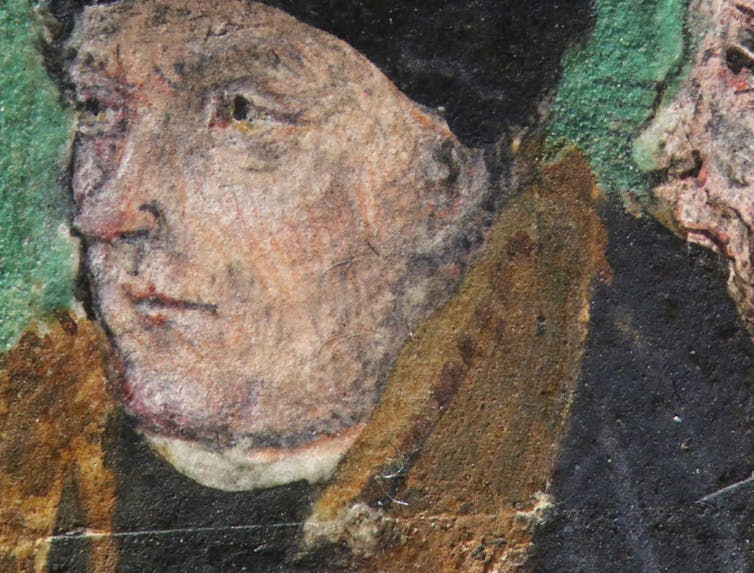
St John’s College, Author provided.
We believe that the instigator of this modification was Cromwell himself and the change had much to do with his representation on the page – a page which illustrates Henry’s complex attitude towards the lay readership of scripture, wavering between distribution and retraction. The same phenomenon, more nuanced but equally powerful, is evident in this careful modification. The pasting of Cromwell’s portrait had reshuffled political powers and affinity to the monarch.
In the original black-and-white design, Cromwell is affiliated with distributing the Bible to the laity – his coat of arms is in the middle of the page, below the figure whose features resemble Cromwell, handing the Bible (inscribed verbum dei, or “the Word of God”) to lay nobility. He mirrors Cranmer’s image, on the other side of the page, distributing a similar book to the clergy. This accorded with Cromwell’s central role in lay administration, as with his reformed leaning and his support for the printing of the Great Bible. In this image, then, Cromwell is on the level below the King and positioned in the middle of the page.
In the painted version of the title page, on the other hand, Cromwell is moved up a level and transformed into the person receiving the book from Henry’s left hand. This serves two purposes. It enhances the affinity between Cromwell and Henry, placing them next to each other. It also renders Cromwell in a more passive position, receiving the book from Henry rather than actively distributing it. Given Henry’s ambivalence towards the lay readership, this was a much less hazardous position. The careful and extensive modifications of the title page demonstrate Cromwell’s political prowess and his ability to read the political map and manipulate the visual image accordingly.
This transformation was both careful and premeditated. A back-light exposure reveals that the faces underneath the pasted elements had not been previously painted in, but rather left blank – anticipating the subsequent pasting. The scientific analysis reveals that the two faces were painted at the same time, most likely in a setting different from the painting of other features in the Bible. Very similar pigment mixtures were used across the two faces and they differ from those employed for flesh tones in the rest of the Bible.
Similarly, the pigments used in the uppermost sections of the fur garments in which the two figures are cloaked (those closest to the faces) differ from those identified in the lower portions of the garments. The same is true for the green brushstrokes surrounding the faces, painted with posnjakite (a copper sulphate mineral) unlike the rest of the grassy landscapes, which were painted in a different sulphate of copper.
This all suggests a targeted campaign. The separation between the painting of the other elements of the presentation copy and the faces reveals that the latter was carried out in a different location and at a later time – most likely in England – after the Bible had arrived from Paris. Reallocating the painting of the faces to London ensured greater accuracy, especially for those whose likeness was less well known outside of England.
In London, very few artists were capable of such skilled and intricate work. The workshops of either Lucas Horenbout or Hans Holbein are the likely location where these portraits were painted and inserted into the title page. The involvement of artists with such close ties to Henry’s court (Horenbout was King’s Painter and court miniaturist from 1525 until his death in 1544, and Holbein was also painting for the court by the mid-1530s) would have guaranteed great accuracy in the depiction of key people. The features of the upper pasted face on the title page closely resemble known depictions of Cromwell. The image of him in the hand-coloured title page is probably his last accurate portrait.
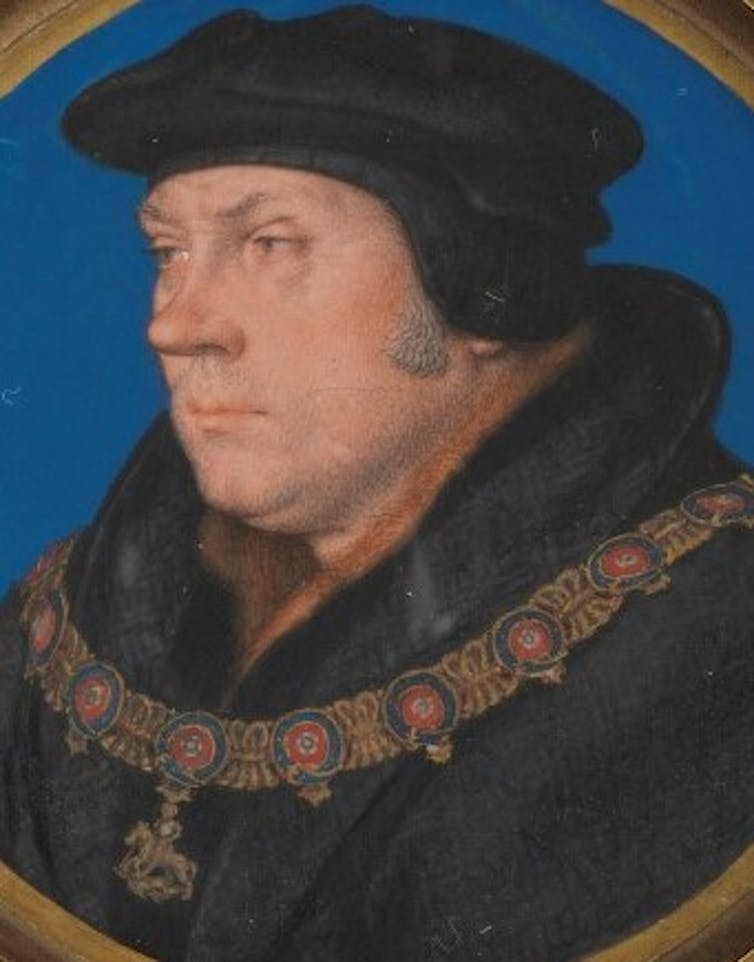
Machiavellian manoeuvring
But who was the second person, distributing Bibles below Cromwell? There is no obvious answer. Based on court politics at the time, and the iconography of the portrait, we believe that this could be Richard Rich, Chancellor of the Court of Augmentations (responsible for dissolving English monasteries) and Speaker of the House of Commons. A comparison between Rich’s known portrait and the pasted face supports this hypothesis.
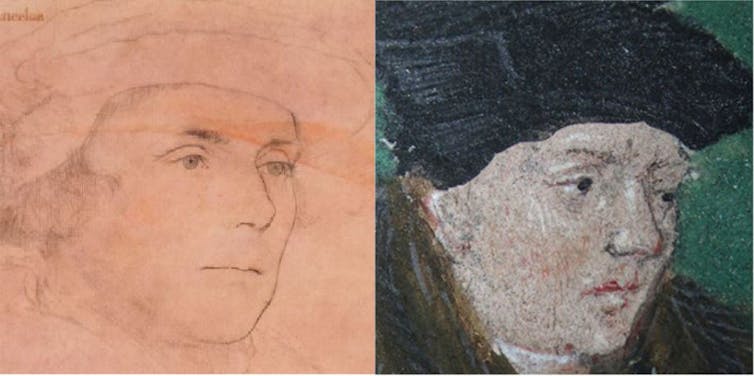
This would demonstrate, once again, Cromwell’s political manoeuvring. Rich, once an affiliate of Cromwell and a leading politician at the court, would have been a natural ally in the dissemination of the Bible to the laity. By placing him underneath, further removed from Henry and closer to the more tricky endeavour of empowering the lay readership, Rich was presented as subordinate to Cromwell (which was not the case at the time) and with a clearer evangelical stance (again, this was not the case).
Rich was instrumental in facilitating the execution of Cromwell soon after and this may attest to Cromwell’s distrust of him. A few years earlier, Rich’s testimony was key in the executions of John Fisher and Thomas More.
Jane Seymour
The image of the woman on the bottom right of the page (and in front of the prison in the black-and-white page) was also changed in the painted copy. In the printed image, a woman is sitting next to a group of children, her hair in curls, possibly with a white undercap. Her hands instruct the children, while she is facing the man on her left (who appears to be the prison warden).
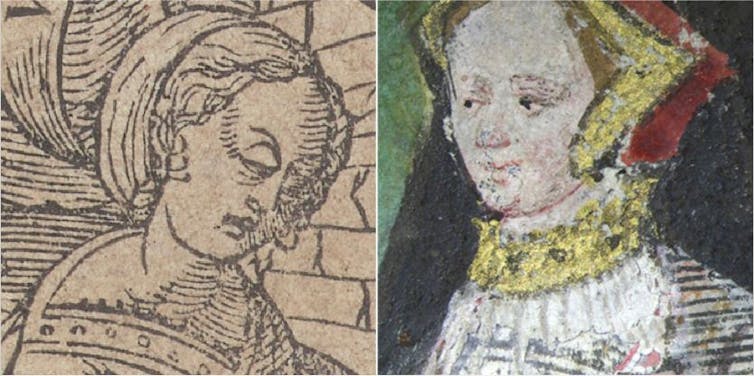
Cambridge University Library/St John’s College, Author provided.
In the painted image, however, this was completely transformed. The woman now faces the children and her features are more distinct and more subtle. Her headgear has been turned into a lavish gable hood, worn by nobility and royalty. This sumptuous gable, trimmed in gold and possibly jewelled, together with the distinctive facial features are reminiscent of Holbein’s portrait of Jane Seymour, painted in 1536.
The portrait was well known at the time and served to inspire other depictions of Jane Seymour, who was Queen of England from 1536 to 1537 as Henry’s third wife. One such portrait was made in 1539 – the same year as the hand-painted title page. The importance of this figure is revealed when looking at the materials used for its creation.
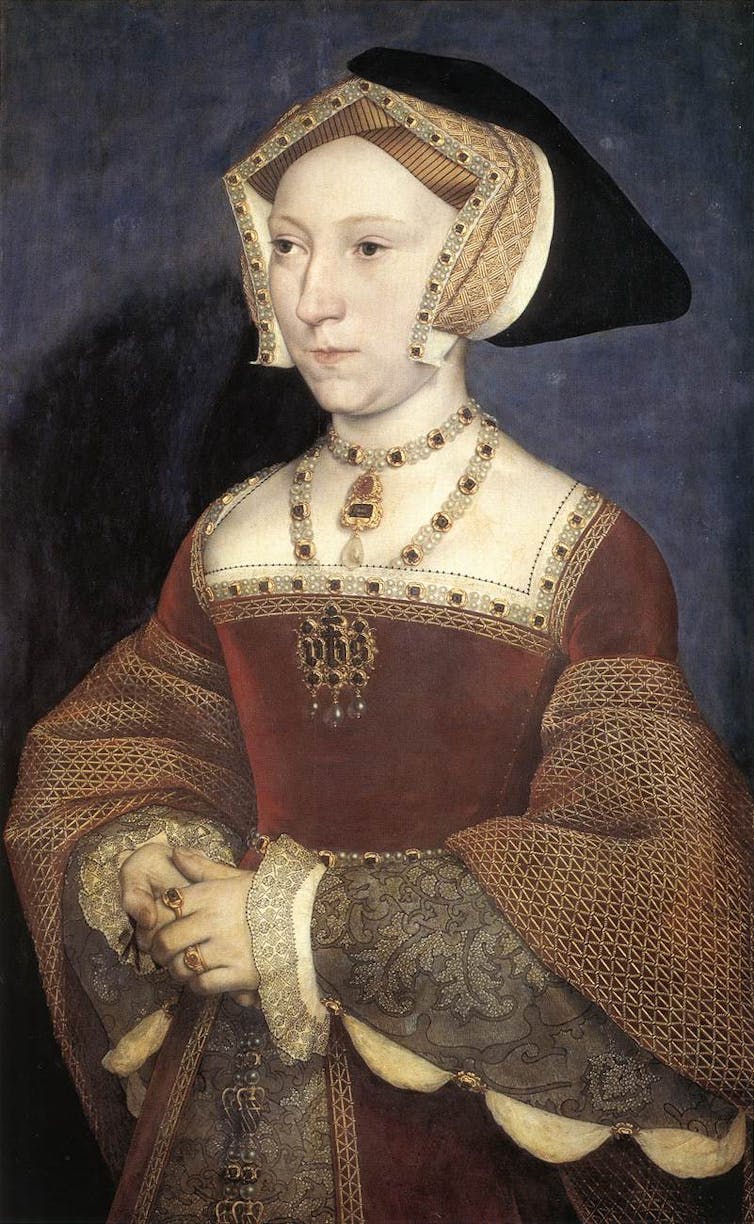
The woman’s headdress and collar are the only instances where gold leaf was used on the page. Every other gilded area was decorated using “shell” (or powdered) gold. Pigment analysis also reveals the dress, which appears white with dark grey lines, contained tarnished silver. This combination of dazzling gold and silver makes the woman a truly spectacular addition to the colour title page.
Cromwell and Cranmer had previously used the King’s affinity to Seymour to elicit his support for the English Bible. In 1537, they evoked her pregnancy in the dedication to Henry which prefaced the Matthew Bible. The title page of that Bible proclaimed: “Set forth with the King’s most gracious licence.” Seymour’s pregnancy led to the birth of the future Edward VI – Henry’s much sought-after male heir. It is little wonder then that the woman in the painted title page is instructing a group of children, with her gaze directed to them – unlike the turned head of the woman in the original image.

Ian McKee/St John’s College, Author provided.
Seymour died shortly after labour on October 24, 1537. Henry grieved for her and cherished her memory. Her loss permeated throughout the remainder of his life and he was subsequently buried at her side at Windsor Castle. A further change of mind about this female portrait is evident in the hand-painted title page. The analysis of the woman’s dress reveals an additional layer of modification, which attests to a later transformation of the figure. Under a microscope, it becomes evident that the white of the upper part of the dress conceals a red layer of paint.
The dress was therefore originally red with a low neckline, mirroring the dress worn by Seymour in the Holbein portrait and was later modified. The motivation for this later transformation is not yet known.
Political upheaval and betrayal
The importance of this presentation copy of the Great Bible – and its sister copy held in Wales – should not be underestimated. These copies were most likely the first ones seen by Henry and his court.
The modifications we have uncovered provide a unique insight into Cromwell’s thought process. Between the design of the printed title page and the hand-colouring, he has grown more cautious and more weary of Henry’s support of the English Bible and reform in general. As a result, he wished to distance himself from the role of distributing Bibles and instead put in his place the person who was to play a key role in his downfall and execution.
The Great Bible was reprinted in six subsequent editions, all produced in quick succession between 1539 and 1541. Henry approved of the printed title page, which was kept in all editions – and later even replaced the title page to the New Testament. However, further transformations to the title page reveal the political upheavals which were to come and the ultimate fate of Cromwell.
Shortly after the appearance of the Great Bible, Cromwell devised Henry’s ill-fated marriage to Anne of Cleves in January 1540. The conservative faction in court used this opportunity to move against Cromwell, leading to his execution in July 1540 – in which the perfidious testament of Rich was instrumental.
The printers of subsequent editions of the Great Bible faced the problem of retaining the image of a convicted traitor. The solution was not to replace the woodcut used for printing altogether (a cumbersome and very costly endeavour). Instead of erasing Cromwell’s image entirely, they erased his coat of arms from the fourth edition of November 1540 and all subsequent editions thereafter.
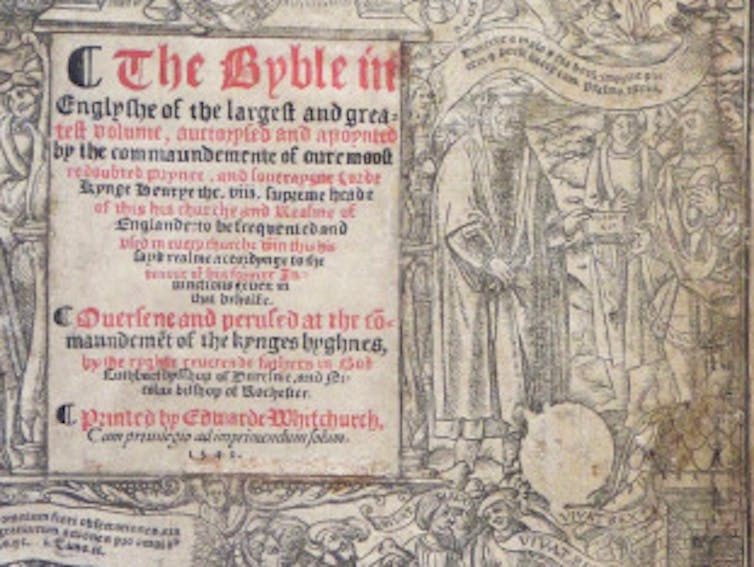
Rather than completely obliterating Cromwell’s memory, the blank circle reminded readers of the fate of traitors to the Crown. Henry also grew disillusioned with the dissemination of bibles to the laity. He came to realise that reality was different to the ideal of the printed title page, and that reading the Bible did not necessarily lead people to shout “long live the king”, but rather to think for themselves.
Cromwell’s fear, leading him to rejig the images, became a reality. Henry’s distrust of lay reading led to legislation in 1543, prohibiting lay women and men of the lower classes from accessing the Bible. Our analysis reveals how key players reacted to political and religious changes. The image modifications have laid bare the truth of the English Reformation period and illustrated just how dangerous and political 16th-century England was – especially in the court of King Henry VIII.
This article is republished from The Conversation under a Creative Commons license. It was published in the series Art for Trying Times in which authors “nominate a work they turn to for solace or perspective during this pandemic”. Read the original article.
